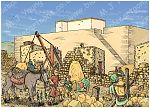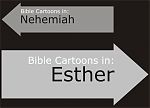Bible Cartoon: Nehemiah 03 - Rebuilding Jerusalem's walls - Scene 04 - Sons of Hassenaah rebuild the Fish Gate
Click on Add to cart button below shopping cart.
Purchased Bible Cartoons do not have watermarks. Links to Cartoons provided on email once purchase is completed.Bible Book: Nehemiah
Bible Book Code: 1600300301
Scene no: 4 of 4
Bible Reference & Cartoon Description
Nehemiah 3:3 (ANIV)
The Fish Gate was rebuilt by the sons of Hassenaah. They laid its beams and put its doors and bolts and bars in place.
DRAWING NOTES:
TIME OF DAY:
The text doesn’t specify a time of day, so I’ve set it at about mid morning.
LIGHTING NOTES:
Sunlight, coming from high above (East) illuminates the scene.
CHARACTERS PRESENT:
In the middle foreground: two men (the sons of Hassenaah) are pointing at the gate & discussing the work.
In the left foreground: a man (from Tyre) is bringing fish on a pole into the city of Jerusalem.
Other Hebrew related people, building a wooden structure to support the gate under construction.
A Raven.
RESEARCH/ADDITIONAL NOTES:
The Hebrew word “Hassenaah” means the thorny; the bristling; the thorn brush; the pointed. Notice that I have drawn the two sons of Hassenaah with prickly bears * their robes with spiky hems, to reflect the Hebrew meaning of their family name!
Although some Bible commentators think the name may refer to a place name, probably the same as Senaah (Ezra 2:35; Nehemiah 7:38) with the definite article, i.e. has-Senaah. In any case, Nehemiah 3:3 tells us that the sons of this man built the fish gate during the repairing of the walls of Jerusalem.
Here’s the scene without the figures in the foreground.

Background of Nehemiah 03 – Rebuilding Jerusalem’s walls – Scene 04 – Sons of Hassenaah rebuild the Fish Gate
Click on the colour bar below to view/buy this Background:
Background of Nehemiah 03 – Rebuilding Jerusalem’s walls – Scene 04 – Sons of Hassenaah rebuild the Fish Gate
It is possible that the gate was called the Fish gate because fish was brought in to Jerusalem from Tyre (an important coastal city on the Phoenician coast, north of Israel) via this gate. Further on in the book of Nehemiah (chp 13 verse 16) we read “Men from Tyre who lived in Jerusalem were bringing in fish and all kinds of merchandise and selling them in Jerusalem on the Sabbath to the people of Judah”, which supports this interpretation of the gate’s name.
I imagine that the original gates had large, vertical, rectangular stone pillars, & possibly large cap stone(s) on top, completing the archway through which people would come in & go out of the gate. There are two very large rectangular cut stones in the middle of this scene, the one on the left is broken in two, the one on the right is leaning up against the right hand side of the old Fish gate aperture. These are the original pillars that held up the capstone (not visible in my scene).
As with the previous scenes, we can see the Temple mount & second temple in the background.
I have included a Corvus corax (aka the Common Raven) perched on a broken beam from the original Fish gate, in the top left of this picture. the Common Raven is a large, all-black passerine [1] bird. It is the largest, & most widely distributed of all corvids (the crow taxonomic family), found across the Northern Hemisphere. the Common Raven has a large bill, long wings & in flight, it shows a diamond-shaped tail. This bird typically measures 23.6-26.7 inches (60-68 cm) in length, has a wingspan of 47.2-59 inches (120-150 cm) & weighs 1.76-3.3 pounds (800-1,500 grammes). They eat Carrion, mammals, birds and eggs, insects and other invertebrates.
[1]
Passerine, meaning of, or relating to, the largest order (Passeriformes) of birds which includes over half of all living birds and consists chiefly of altricial songbirds of perching habits. Birds in this order are characterized by having four toes, three directed forward and one backward, all joining the foot at the same level.

Map of the walls and gates of Jerusalem at the time of Nehemiah
The blue dot & arrow on the map shows the position of the viewer & their direction of view in the scene above.
Click on the colour bar below to view/buy this Map (Note – bought map has no watermark):

Map of the Walls and Gates of Jerusalem at the time of Nehemiah





